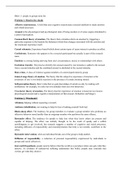Summary
Summary Terms of block 1.1C People in Groups
- Course
- Institution
All terms of Block 1.1C people in Groups Including problems: 1. Head in the clouds 2. Whodunnit? 3. I spy.... 4. Attitudes 5. The individual within the group 6. Your wish is my command? 7. First Impressions 8. All you need is love
[Show more]




